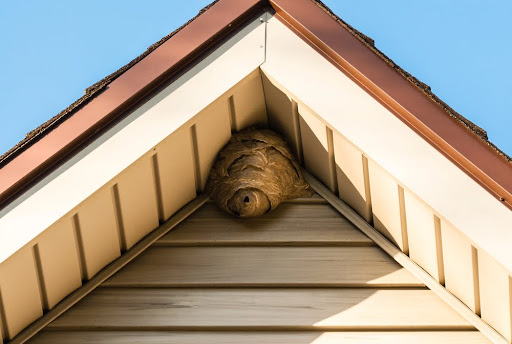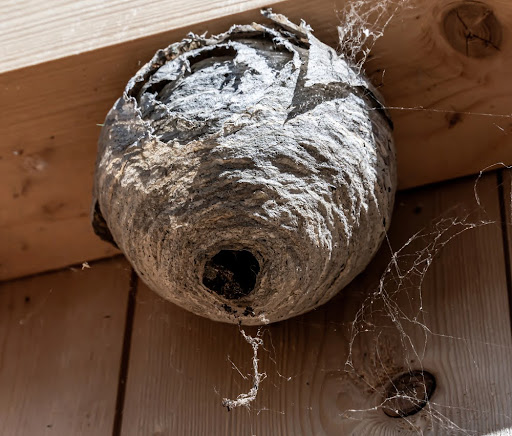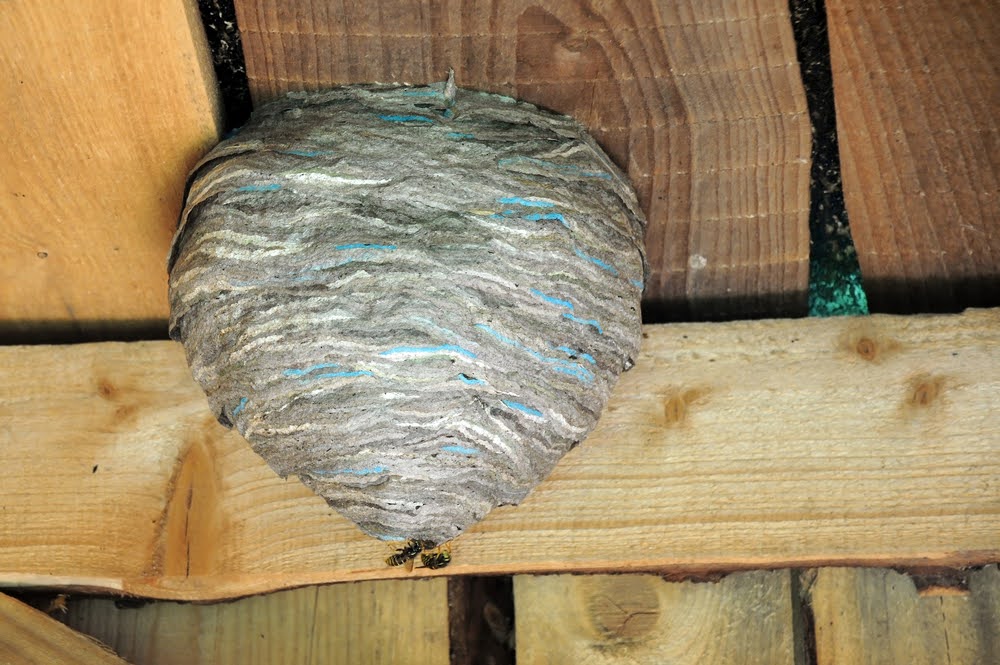You’re enjoying a warm summer evening in your backyard in Gahanna or Clintonville, sipping on a glass of ice-cold iced tea, when you notice it.
A buzzing flurry of activity near the corner of your garage roof. A hornets’ nest.
And unfortunately, it’s steadily growing and way too close for comfort. But before you grab a spray can, hold on. When is the best time to spray a hornets’ nest, and is this even a task you should tackle on your own? Believe it or not, timing matters more than you might think when dealing with these stinging insects.
Here’s everything you need to know about when, why, and how to spray a hornets’ nest safely and effectively in Columbus, OH.
Understanding Hornets and Their Nests

Hornets, just like their cousins yellowjackets, dirt daubers, and paper wasps, are social insects that thrive in late spring and summer.
Their colonies grow throughout the season, peaking in late summer or early fall, with some large nests hosting up to 1,000 workers. European hornets, the most common type in Ohio, build their nests in tree hollows, siding, wall voids, or under building eaves.
By late autumn, freezing temperatures kill off the workers, leaving only a few fertilized queens to overwinter and start new colonies in spring. Nests are never reused, making proper timing critical for any removal attempts.
When is the Best Time to Spray a Hornets’ Nest?
The best time to spray a hornets’ nest is early in the morning or late at night. Here’s why:
- Hornets are less active during cooler, darker times of the day. Most will be inside the nest, making sprays more effective.
- You’re less likely to get stung, as hornets are diurnal (they sleep at night) and their aggressive behavior is significantly reduced.
Spraying a nest during the daytime increases the risk of being swarmed. Plus, hornets foraging away from the nest won’t come in contact with the spray, limiting its effectiveness.
Note that weather matters, too. Choose a calm, mild day with no rain in the forecast. Wind can carry the spray off-target, and rain can wash it away too soon.
Step-by-Step Guide to Spraying a Hornets’ Nest

When you’re ready to tackle a hornets’ nest, follow these steps to make sure you do it safely:
1. Choose Your Spray
Pick a long-range wasp and hornet spray with a jet spray that allows you to stay at least 15–20 feet away from the nest. Look for labels that promise immediate knockdown and residual action for lasting effects.
2. Dress for the Job
Wear protective clothing, including long sleeves, pants, gloves, closed-toe shoes, and a hat or hood for extra coverage. If you can, avoid bright clothes or strong fragrances, as they can attract hornets.
3. Plan Your Escape Route
Before you spray, map out a quick path to retreat in case the situation gets out of hand. It’s also helpful to have a backup observer nearby to ensure everything goes smoothly.
4. Spray and Retreat
Stand at a safe distance and aim the spray nozzle directly at the nest opening. Use a sweeping motion to cover the entire nest thoroughly.
After you’ve sprayed, retreat immediately and avoid returning until the hornet activity has ceased, usually 24–48 hours later.
5. Dispose of the Nest
Once all activity has stopped, don’t forget to remove the nest. This prevents other insects from scavenging it. Use a stick or long object to detach the nest, bag it securely, and dispose of it in the trash.
Don’t Feel Comfortable? Give Green Shield a Call

Dealing with a hornets’ nest isn’t for everyone. If the nest is in a hard-to-reach location like a high tree branch or within your home’s wall voids (or if someone in your home has allergies to stings), it’s best to call in professional pest control services.
At Green Shield Pest Pros, we specialize in safe, effective hornet removal right here in Columbus, OH.
If you’re unsure about removing a hornets’ nest, trust our team at Green Shield Pest Pros. We’re proud to serve neighborhoods like Upper Arlington, German Village, and Bexley with expert pest control solutions tailored to your local needs.
Don’t wait until the problem gets bigger – we’re ready to protect your home and peace of mind. Click here to book a free consultation.
Did You Know?
European hornet nests can grow to house over 1,000 workers by mid-September, but that’s nothing compared to eastern yellowjackets, whose nests can hold up to 5,000 individuals at their peak! Luckily, hornets’ nests naturally decline with the first hard frost.
FAQ
When is the best time of year to remove a hornets’ nest?
Spring and early summer are ideal since nests are small and contain fewer hornets. However, spraying works through mid-autumn as long as you follow safe practices.
Can hornets reuse a nest?
No. Hornets’ nests are used for only one season. The colony dies off in late fall, and queens find new locations to build nests each spring.
Is it dangerous to spray a hornets’ nest myself?
It can be. Without proper preparation or timing, you risk provoking aggressive hornets. Professional pest control services are a safer option for large or hard-to-reach nests.
